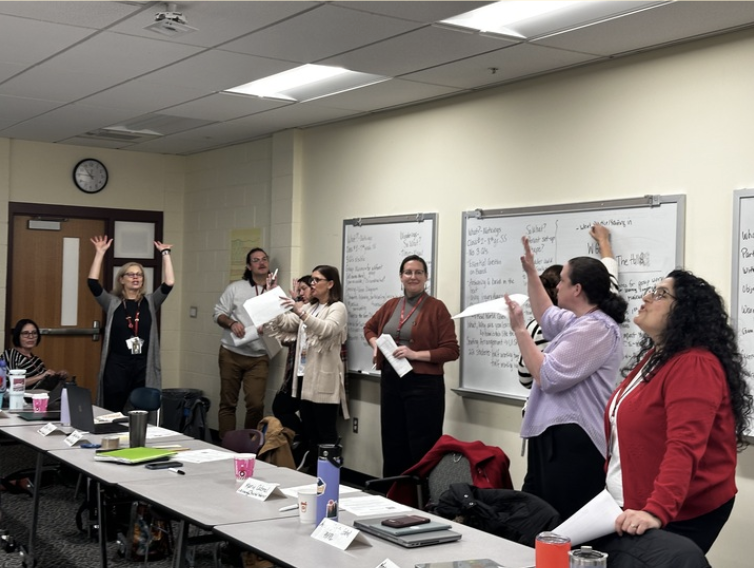The PL Network brings together six RI districts that are focused on improving classroom instruction and student outcomes through curriculum-based professional learning (CBPL) for evidence-based and data-driven collaboration with Annenberg’s RI Education Research team. On Wednesday, December 11, the PL Network visited Woonsocket Education Department’s two middle schools for a Deep Dive. Woonsocket Director of Curriculum and Development Dr. Angie Holt and Director of Multilingual Learners Rania Aghia led the group through a half-day of observations and discussion.
In the PL Network’s first Deep Dive in Narragansett, we gained some insight into the way districts are working to bring together HQCM and the district’s vision for instruction - putting them “in sync.” In both Narragansett and Woonsocket, this means helping teachers to implement HQCM consistently with the district’s strategy for active, student-centered learning. In Woonsocket, network members observed instruction in middle school Social Studies classrooms where teachers are piloting new high quality curriculum material (HQCM) and talked with district Innovation Specialists, the coaches, about the professional learning support they provide.

What we learned about CBPL in Woonsocket:
- Grounding in the standard helps teachers prepare to teach using HQCM that is new to them. Helping teachers to focus on the learning outcome–even when the standards are not explicitly linked in the curriculum–is a coaching move that Woonsocket Innovation Specialists use to keep teachers focused on what students will understand and be able to do.
- Student collaboration and discussion is high-impact when the task is challenging and requires students to grapple. Coaches can support active, student-centered learning by helping teachers to identify which parts of units and lessons in the curriculum are suited to their structures for student collaboration and discussion. For example, a unit launch that builds students’ background knowledge isn’t likely to be a high-impact moment for collaborative learning structures. Tasking students with discussion at that point could lead to procedural instruction and pacing challenges. But later in the same unit, when students are analyzing primary source documents, collaboration and discussion could deepen student learning, improve students’ communication skills, and increase student investment.
- Concrete tools and protocols for student collaboration and discussion remain key to effective student-centered instruction when teachers are implementing new HQCM. During the Deep Dive, visitors heard student and teacher testimonials about how “teaming” structures, including cards students can refer to for support in discussion, had facilitated more student voice, higher engagement, and more active learning. While implementing a new curriculum, coaches can support teachers to continue using these practices from the district’s model of instruction to support their efforts around student collaboration and discussion.
What Leaders Are Saying
Deep Dive participants returned to their districts across the state with concrete resources and next steps for their own PL leadership.
“Today’s findings will help me in my coaching of how to adapt a high quality curriculum for our model of instruction.”
“I am modeling in a classroom tomorrow. I am already thinking about more intentional moves to structure student collaboration and better facilitate the transfer of teacher moves from the model to practice.”
“Today’s learning will drive coaching decisions and strategies to support classroom teachers.”
“This was a reflective model that helps Woonsocket, but I see the same instructional needs and next steps to bring to our district.”
The next PL Deep Dive will be happening in Bristol-Warren on January 15th. Please contact Brenda Santos ([email protected]) if you are interested in learning more about Annenberg’s work with Rhode Island schools.